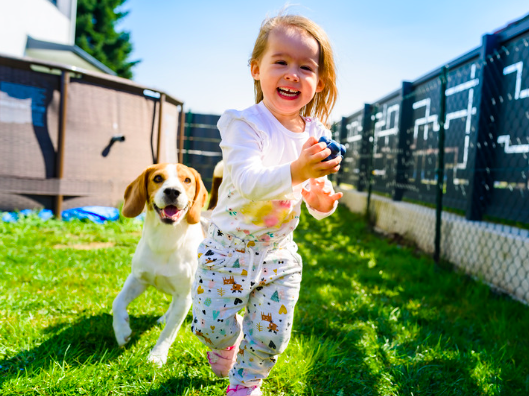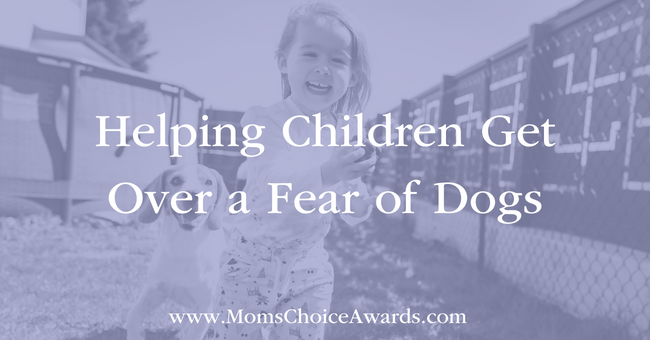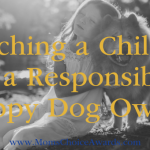 Jane Sandwood
Jane Sandwood
Teacher | Blogger | Mom
 You might think that only people who have been bitten or chased by dogs might have a fear of them, but a fear of animals is actually one of the most common types of specific phobias. About one in every three people with a phobia of animals fears dogs in particular and many of them may have never had a dog or been in close contact with them. Dogs can bring a host of benefits to human beings’ physical and mental health. Studies have shown they can calm stress and alleviate the symptoms of anxiety, depression, and other conditions. If your child has a fear of dogs (even if that fear does not amount to a phobia), they may be missing out on the unconditional love, companionship, and fun that dogs can bring. How can you help them overcome their worry and come to see the sweet and friendly side of a potential four-pawed friend?
You might think that only people who have been bitten or chased by dogs might have a fear of them, but a fear of animals is actually one of the most common types of specific phobias. About one in every three people with a phobia of animals fears dogs in particular and many of them may have never had a dog or been in close contact with them. Dogs can bring a host of benefits to human beings’ physical and mental health. Studies have shown they can calm stress and alleviate the symptoms of anxiety, depression, and other conditions. If your child has a fear of dogs (even if that fear does not amount to a phobia), they may be missing out on the unconditional love, companionship, and fun that dogs can bring. How can you help them overcome their worry and come to see the sweet and friendly side of a potential four-pawed friend?
Puppy Love
Puppies are soft, cuddly, and usually very gentle, and they are a great way to introduce kids to the joys of simply being in a room with a dog. If you have a trusted friend or loved one who can help you out, ask them to visit you and bring their puppy for a short, five-minute visit. The puppy can be kept in a crate or held by your friend at first. If and only if your child is ready to interact with the puppy, let him out of the crate or let your child very gently interact with the pup. Inform your child that ears and tails should not be pulled!
Visiting the Park
Another way to encounter dogs casually is to visit a nearby park where owners keep their pooches on a leash. Ask a dog owner to help you out and show your child that when you walk past the dog, nothing bad happens. You can also try this out with a friend who will commit to meeting you at the same time on a regular basis. Make it casual, so your child does not feel like they are being forced to interact with the dog. After a few days, you may find that your child displays an interest in the dog and vice-versa. Make sure that your chosen canine has a calm temperament and does not jump up on you or your child, or bark loudly and excitedly when they see you.
Use a Reward System and Talk about Dogs
If your child has allowed a dog to come to her, or has petted a dog on a given day, make them feel special with a special award certificate or present. It could be a stuffed toy they have been eyeing, lunch at their favorite restaurant, or a special experience you can enjoy alongside them. When you are out shopping or having fun, show them pictures of dogs you have grown up with and let them know how special they have been in your life. You can let them know how your dog comforted you in sad times and seemed to intuitively know when you were down in the dumps. Dogs are so in tune to their humans that they watch their body language keenly and listen to the sound of their voice to know more about their moods and intentions. They have an incredible sense of smell, and they can pick up hormonal and other changes. They also have a fascinating way of communicating that humans can learn.
Seeking Professional Help
If your child has a phobia, it can help to seek help from a trained psychotherapist. The latter can suggest one of a number of treatments. Just a few successful therapies include exposure therapy (gradually exposing your child to dogs/holding dog toys/watching videos of dogs); cognitive-behavioral therapy (which encourages kids to think about dogs in a more positive way); and mindfulness exercises (like controlled breathing and meditation). Approaches like exposure therapy can actually help solve the problem in a very small number of sessions, which may make them worthwhile if your child’s fears are severe.
Dogs are everyone’s best friend, but not if you are afraid of them. You can help your child in many gentle ways, enlisting the help of family and friends. When your child’s fears amount to a phobia, meanwhile, therapy can help them see dogs through a more positive lens.
 About Jane Sandwood
About Jane Sandwood
Jane has been a freelance writer and editor for over 10 years. She has written for both digital and print across a wide variety of fields. Her main interest is exploring how people can improve their health and well-being in their everyday life. And when she isn’t writing, Jane can often be found with her nose in a good book, at the gym or just spending quality time with her family.
View all posts by Jane Sandwood here.







3 Comments on “Helping Children Get Over a Fear of Dogs”
Knowing how much a beloved dog can enrich our lives, I’ve always felt bad for people that were fearful of them. This is an informative post that can hopefully help people of any age.
The article on helping children get over a fear of dogs was very helpful.
I just got a puppy last month so this is super helpful info!